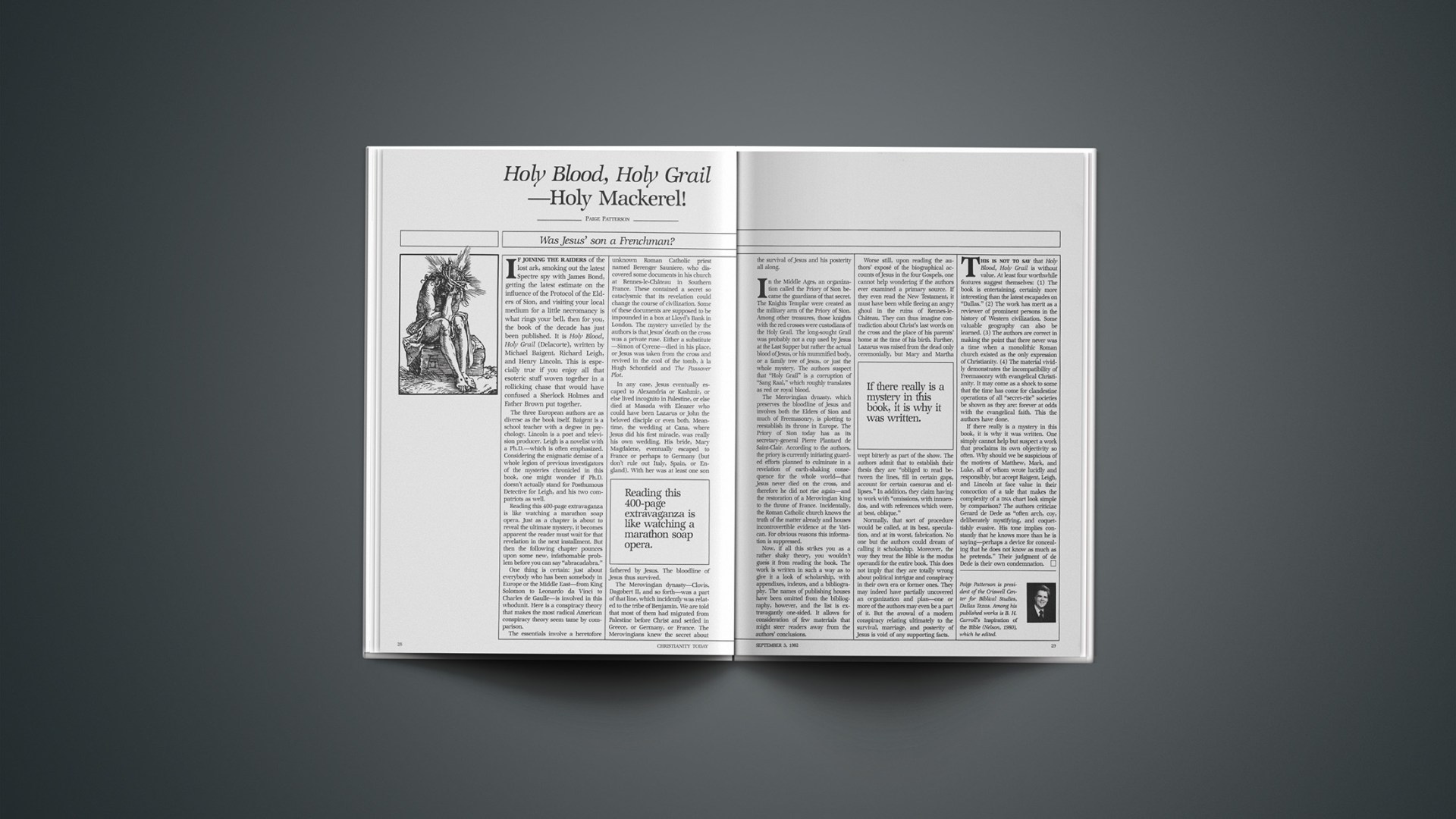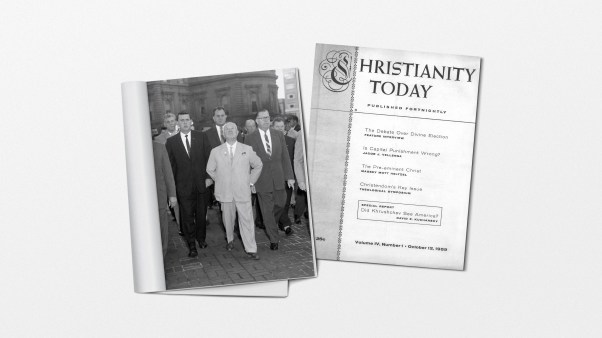Was Jesus’ son a Frenchman?
If joining the raiders of the lost ark, smoking out the latest Spectre spy with James Bond, getting the latest estimate on the influence of the Protocol of the Elders of Sion, and visiting your local medium for a little necromancy is what rings your bell, then for you, the book of the decade has just been published. It is Holy Blood, Holy Grail (Delacorte), written by Michael Baigent, Richard Leigh, and Henry Lincoln. This is especially true if you enjoy all that esoteric stuff woven together in a rollicking chase that would have confused a Sherlock Holmes and Father Brown put together.
The three European authors are as diverse as the book itself. Baigent is a school teacher with a degree in psychology. Lincoln is a poet and television producer. Leigh is a novelist with a Ph.D.—which is often emphasized. Considering the enigmatic demise of a whole legion of previous investigators of the mysteries chronicled in this book, one might wonder if Ph.D. doesn’t actually stand for Posthumous Detective for Leigh, and his two compatriots as well.
Reading this 400-page extravaganza is like watching a marathon soap opera. Just as a chapter is about to reveal the ultimate mystery, it becomes apparent the reader must wait for that revelation in the next installment. But then the following chapter pounces upon some new, infathomable problem before you can say “abracadabra.” One thing is certain: just about everybody who has been somebody in Europe or the Middle East—from King Solomon to Leonardo da Vinci to Charles de Gaulle—is involved in this whodunit. Here is a conspiracy theory that makes the most radical American conspiracy theory seem tame by comparison.
The essentials involve a heretofore unknown Roman Catholic priest named Berenger Sauniere, who discovered some documents in his church at Rennes-le-Château in Southern France. These contained a secret so cataclysmic that its revelation could change the course of civilization. Some of these documents are supposed to be impounded in a box at Lloyd’s Bank in London. The mystery unveiled by the authors is that Jesus’ death on the cross was a private ruse. Either a substitute—Simon of Cyrene—died in his place, or Jesus was taken from the cross and revived in the cool of the tomb, à la Hugh Schonfield and The Passover Plot.
In any case, Jesus eventually escaped to Alexandria or Kashmir, or else lived incognito in Palestine, or else died at Masada with Eleazer who could have been Lazarus or John the beloved disciple or even both. Meantime, the wedding at Cana, where Jesus did his first miracle, was really his own wedding. His bride, Mary Magdalene, eventually escaped to France or perhaps to Germany (but don’t rule out Italy, Spain, or England). With her was at least one son fathered by Jesus. The bloodline of Jesus thus survived.
The Merovingian dynasty—Clovis, Dagobert II, and so forth—was a part of that line, which incidently was related to the tribe of Benjamin. We are told that most of them had migrated from Palestine before Christ and settled in Greece, or Germany, or France. The Merovingians knew the secret about the survival of Jesus and his posterity all along.
In the Middle Ages, an organization called the Priory of Sion became the guardians of that secret. The Knights Templar were created as the military arm of the Priory of Sion. Among other treasures, those knights with the red crosses were custodians of the Holy Grail. The long-sought Grail was probably not a cup used by Jesus at the Last Supper but rather the actual blood of Jesus, or his mummified body, or a family tree of Jesus, or just the whole mystery. The authors suspect that “Holy Grail” is a corruption of “Sang Raal,” which roughly translates as red or royal blood.
The Merovingian dynasty, which preserves the bloodline of Jesus and involves both the Elders of Sion and much of Freemasonry, is plotting to reestablish its throne in Europe. The Priory of Sion today has as its secretary-general Pierre Plantard de Saint-Clair. According to the authors, the priory is currently initiating guarded efforts planned to culminate in a revelation of earth-shaking consequence for the whole world—that Jesus never died on the cross, and therefore he did not rise again—and the restoration of a Merovingian king to the throne of France. Incidentally, the Roman Catholic church knows the truth of the matter already and houses incontrovertible evidence at the Vatican. For obvious reasons this information is suppressed.
Now, if all this strikes you as a rather shaky theory, you wouldn’t guess it from reading the book. The work is written in such a way as to give it a look of scholarship, with appendixes, indexes, and a bibliography. The names of publishing houses have been omitted from the bibliography, however, and the list is extravagantly one-sided. It allows for consideration of few materials that might steer readers away from the authors’ conclusions.
Worse still, upon reading the authors’ exposé of the biographical accounts of Jesus in the four Gospels, one cannot help wondering if the authors ever examined a primary source. If they even read the New Testament, it must have been while fleeing an angry ghoul in the ruins of Rennes-le-Château. They can thus imagine contradiction about Christ’s last words on the cross and the place of his parents’ home at the time of his birth. Further, Lazarus was raised from the dead only ceremonially, but Mary and Martha wept bitterly as part of the show. The authors admit that to establish their thesis they are “obliged to read between the lines, fill in certain gaps, account for certain caesuras and ellipses.” In addition, they claim having to work with “omissions, with innuendos, and with references which were, at best, oblique.”
Normally, that sort of procedure would be called, at its best, speculation, and at its worst, fabrication. No one but the authors could dream of calling it scholarship. Moreover, the way they treat the Bible is the modus operandi for the entire book. This does not imply that they are totally wrong about political intrigue and conspiracy in their own era or former ones. They may indeed have partially uncovered an organization and plan—one or more of the authors may even be a part of it. But the avowal of a modern conspiracy relating ultimately to the survival, marriage, and posterity of Jesus is void of any supporting facts.
This is not to say that Holy Blood, Holy Grail is without value. At least four worthwhile features suggest themselves: (1) The book is entertaining, certainly more interesting than the latest escapades on “Dallas.” (2) The work has merit as a reviewer of prominent persons in the history of Western civilization. Some valuable geography can also be learned. (3) The authors are correct in making the point that there never was a time when a monolithic Roman church existed as the only expression of Christianity. (4) The material vividly demonstrates the incompatibility of Freemasonry with evangelical Christianity. It may come as a shock to some that the time has come for clandestine operations of all “secret-rite” societies be shown as they are: forever at odds with the evangelical faith. This the authors have done.
If there really is a mystery in this book, it is why it was written. One simply cannot help but suspect a work that proclaims its own objectivity so often. Why should we be suspicious of the motives of Matthew, Mark, and Luke, all of whom wrote lucidly and responsibly, but accept Baigent, Leigh, and Lincoln at face value in their concoction of a tale that makes the complexity of a DNA chart look simple by comparison? The authors criticize Gerard de Dede as “often arch, coy, deliberately mystifying, and coquettishly evasive. His tone implies constantly that he knows more than he is saying—perhaps a device for concealing that he does not know as much as he pretends.” Their judgment of de Dede is their own condemnation.
Paige Patterson is president of the Criswell Center for Biblical Studies, Dallas Texas. Among his published works is B. H. Carroll’s Inspiration of the Bible (Nelson, 1980), which he edited.









